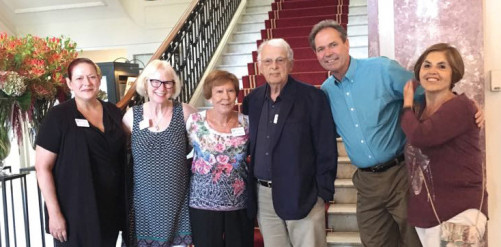January 2016
I had a medical procedure for uterine fibroids and was referred to an oncologist. No cancer was detected at that time, and I went on with my life. I was taking care of my husband, who had been diagnosed with multiple myeloma in 2015.
August 2016
I started getting pains in my lower abdomen, which I thought were because I was working too hard caring for my husband. I went back to the oncologist, who did an ultrasound and told me that I had ovarian cancer. Two weeks later, I was on the operating table to get a hysterectomy and nearby lymph glands removed. I had Stage IV metastatic high-grade ovarian cancer with no BRCA mutation. Six weeks later, I began receiving chemotherapy.
November 2016
I was offered a clinical trial of chemotherapy plus an experimental PARP inhibitor. No one told me about losing your hair and all the other side effects. One morning, I was combing my hair, and it came out by the handful. It was quite a shock.
During the two years of the clinical trial, I stayed in remission, though my oncologist told me that I could expect to have recurrences.
April 2017
My husband passed away in the hospital. Between his death and my treatment, it was rough, but I continued on with the business of everyday life and my clinical trial. I wasn’t going to give up, no matter how hard it got.
July 2018
My oncologist twisted my arm to join the hospital’s Woman to Woman program as a mentor to other cancer patients. Woman to Woman trains women to support others who are newly diagnosed. You can meet with them or talk to them on the phone or internet—it’s whatever works best for you. I had my hands full, but my oncologist insisted. There are lots of support groups out there, and I strongly recommend that people join them. You should know that you’re not alone.
I belong to three other organizations too, and they really keep me going. I’m a member of the United Way Health Impact Council, which reviews grant applications for local funding agencies. I’m on the institutional review board at Nova Southeastern University, where we review clinical applications, and I’m on the board of Fight for Sight, which supports vision research.
My background definitely had an impact on how I manage my care. I was an administrator for the University of Miami School of Medicine for many years, and I’m a real advocate for medical centers that have a teaching hospital. You’ve got your best opportunity there because they have access to clinical trials and state-of-the-art equipment that are not available to a physician in private practice.
August 2018
My three children and I took a riverboat cruise down the Rhine, through Switzerland, Italy and Germany.
I thought I was doing really well until a CT scan found a recurrence. I was immediately removed from the clinical trial—six weeks before it ended. I was so disappointed.
People should advocate for themselves. You don’t have to take the doctor’s word as gospel. My doctor and I have a lot of arguments, but we still love each other. If I don’t like what he wants to do, he’s got to convince me. I have a pad and pencil by my sofa. When something occurs to me, I write it down so I can tell him about my side effects and ask all my questions.

Gaby Kressly with her family in Lucerne, Switzerland, 2018Courtesy of Gaby Kressly
September 2018
I started a different chemotherapy regimen once a month for six months. It was very difficult, as the infusion was initially very strong. They made it a little less strong when I could not tolerate it well. It was four to six hours every time, but they treated me very nicely: You could get your feet massaged, and there was an art cart, so you could string beads and paint pictures.
Each month, I had 10 days to two weeks to chill out from the chemo and two weeks to live. I did a lot of living in that time.
December 2018
My children and I met in Albuquerque, New Mexico, and we had a wonderful Christmas. Next fall, we are planning to go on a cruise from New England into Canada to see the leaves.
March 2019
I had my last chemo treatment, followed by a CT scan, which showed that the tumor had shrunk a bit but is still there. I’m starting a new PARP inhibitor—a daily pill—and I will stay on it as long as it works.
July 2019
The PARP inhibitor has to be taken every night before bed. I did not tolerate the initial dose well—it was almost worse than chemo. The dose was cut in half, and it was much better. I still have a lot of nausea and always feel tired. However, this new drug has given me some of my life back. I can work some, and I am able to travel and do things I like. The last CT scan showed the tumor shrinking and no new invasions.

Gaby Kressly in Key West, 2019Courtesy of Gaby Kressly
Basics
BRCA mutation—BRCA genes influence susceptibility to cancer. People with certain BRCA mutations cannot repair damaged DNA, which allows cancer cells to grow out of control.
PARP inhibitor—a type of targeted therapy that works by blocking a protein that plays a role in DNA repair. Interfering with PARP leads to more DNA breaks, which can halt cancer cell division.
Stage IV cancer—cancer that has metastasized, or spread beyond its original location to other parts of the body.
Click here to learn more about ovarian cancer.







1 Comment
1 Comment